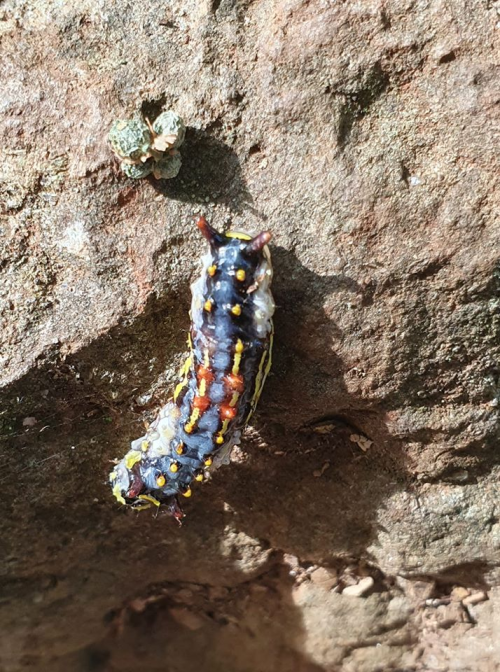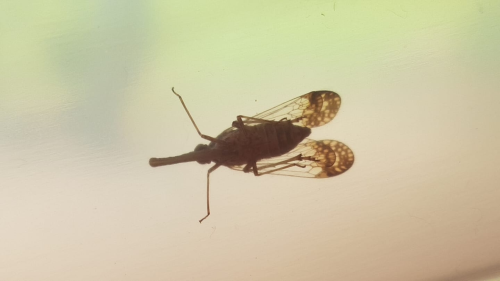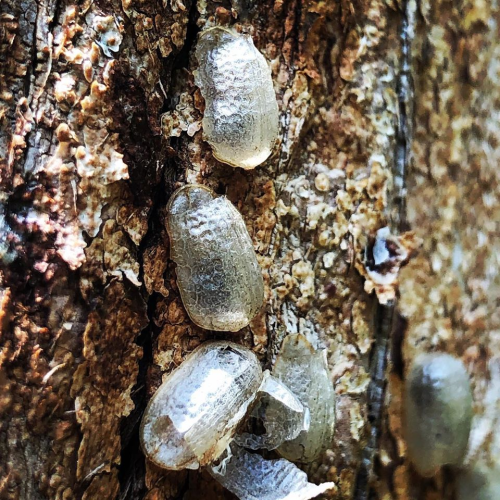#1595-1599 - More Stuff
#1595 - Lactura sapotearum

Formerly Physicampa sapotearum, and found in Queensland and NSW. Photo by Josh Macbeth, Tambourine Mt., Queensland.
The Caterpillars of this species have two large white patches on each side of the body, inflated when the caterpillar is disturbed, which they follow up by exuding a very sticky substance. The caterpillars start off blue-grey, with two tubercles on the back of each segment. These bumps are yellow on most segments except in early instars when the middle two are red. Later instars are blue-grey with longitudinal yellow stripes. There are two red or yellow horns on the prothorax and at the end of the abdomen.
The caterpillars feed by day on plants in Sapotaceae, including Black Apple ( Planchonella australis ), and Yellow Boxwood ( Planchonella pohlmaniana ), and pupate in crevices of the bark of the tree in stiff white cocoons.
The adult moths have a wingspan of 4cm, with red forewings and dark veins, and yellow markings at all three corners. The hindwings and abdomen are plain scarlet. The males are paler than the females.
This moth was originally described by Alexander Scott in a manuscript based on drawings by his daughters: Harriet and Helena, to be published in three volumes. Sadly he never managed to get Volume 3 printed, so the credit of first description goes to William Swainson, who reviewed the manuscript pre-publication in the ‘Sydney Morning Herald’ in 1851, with some brief descriptions of this and other species.
#1596 - Thanatodictya sp.
Adult and nymph, this time, since they both got sent to me the same week.

Peter Jettner in Darwin. Probably Thanatodictya (Thanatodictya) praeferrata.

A nymph spotted by Mark Bell-Humphrey.
At first glance they’re Fulgorid lanternflies, but they’re actually Dictyopharids, a related family with about 760 species in 150 genera.
I did learn something interesting while reading up on these guys though - the purpose of the pterostigma, a thickened section on the forward edge of the forewing of many flying insects. It helps with gliding flight, by dampening out any vibrations that build up in the wing above a critical speed.
I don’t known if the genus has a preferred diet, but the New Zealand species T. tillyardi is usually associated with bracken fern.
#1597 - Achaea sp.

Photo by Jeff Crocombe, in Brisbane.
I thought it looked like an Erebid, and I was right. I’d initially thought it was A. eusciasta, a moth is found in the islands of SE Asia, Queensland, and Northern NSW. Its caterpillars have been found on Star Apple (Chrysophyllum cainito), which is a little peculiar, since that species of plant is native to the Antilles, even if it’s now widely grown in SE Asia. It’s more likely that the caterpillars have other host plants that no-one has recorded.
But despite the exact match in hindwing pattern, it’s more like that it’s Achaea argilla, which has less boldly marked forewings than most in the genus. This species’ caterpillars have been found on Willgar and Spurge, which are two very different plants, and the latter highly poisonous.
The adults in the genus are pests of tropical fruit, piercing them to suck at the juice.
#1598 - Microdon sp. - Antfly pupa

Found by Katrina Forstner on the trunk of a Stringybark eucalypt in Melbourne.
Microdontine hoverflies are myrmecophiles, living inside ant nests as larvae, where they barely resemble insects at all. In fact they were originally described as molluscs and scale insects. They’re dome-shaped, living deep inside the hosts nest, where some species eat ant larvae, and others scavenge. The adults are often hairy and bee-like, but unlike other hoverflies do not spend time around flowers, instead hovering around the nests of their chosen host species. Little is known about the biology of the 249 known species.
#1599 - Lamprogaster sp.


Erskine, south of Perth.
Photos by Mish Mann and Colin Prickett, after I spotted her low on the trunk of a paperbark, on what is likely to be the last WA Naturalist’s Club field trip for a while.
As to which species of Lamprogaster this is, the results have been ambiguous - Tony D. at iNaturalist says it keys out to near L. hilaris, but the colour of the frons and palps is completely wrong.
But that’s #1599 covered - I’ve got a very special fly ready for #1600…